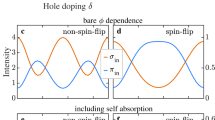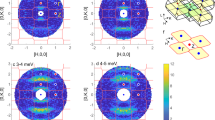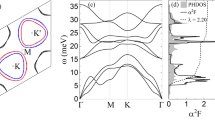Abstract
In conventional superconductors, lattice vibrations (phonons) mediate the attraction between electrons that is responsible for superconductivity1. The high transition temperatures (high-Tc) of the copper oxide superconductors has led to collective spin excitations being proposed as the mediating excitations in these materials2. The mediating excitations must be strongly coupled to the conduction electrons, have energy greater than the pairing energy, and be present at Tc. The most obvious feature in the magnetic excitations of high-Tc superconductors such as YBa2Cu3O6+x is the so-called ‘resonance’3,4,5,6. Although the resonance may be strongly coupled to the superconductivity3,4,5,6,7,8, it is unlikely to be the main cause, because it has not been found in the La2-x(Ba,Sr)xCuO4 family and is not universally present in Bi2Sr2CaCu2O8+δ (ref. 9). Here we use inelastic neutron scattering to characterize possible mediating excitations at higher energies in YBa2Cu3O6.6. We observe a square-shaped continuum of excitations peaked at incommensurate positions. These excitations have energies greater than the superconducting pairing energy, are present at Tc, and have spectral weight far exceeding that of the ‘resonance’. The discovery of similar excitations in La2–xBaxCuO4 (ref. 10) suggests that they are a general property of the copper oxides, and a candidate for mediating the electron pairing.
This is a preview of subscription content, access via your institution
Access options
Subscribe to this journal
Receive 51 print issues and online access
$199.00 per year
only $3.90 per issue
Buy this article
- Purchase on Springer Link
- Instant access to full article PDF
Prices may be subject to local taxes which are calculated during checkout


Similar content being viewed by others
References
Bardeen, J., Cooper, L. N. & Schrieffer, J. R. Theory of superconductivity. Phys. Rev. 108, 1175–1204 (1957)
Chubukov, A. V., Pines, D. & Schmalian, J. in The Physics of Superconductors Vol. I, Conventional and High-T c Superconductors (eds Bennemann, K. H. & Ketterson, J. B.) 495–590 (Springer, Berlin, 2003)
Rossat-Mignod, J. et al. Neutron scattering study of the YBa2Cu3O6+x system. Physica C 185, 86–92 (1991)
Mook, H. A., Yethiraj, M., Aeppli, G., Mason, T. E. & Armstrong, T. Polarized neutron determination of the magnetic excitations in YBa2Cu3O7 . Phys. Rev. Lett. 70, 3490–3493 (1993)
Dai, P. et al. The magnetic excitation spectrum and thermodynamics of high-Tc superconductors. Science 284, 1344–1347 (1999)
Stock, C. et al. Dynamic stripes and resonance in the superconducting and normal phases of YBa2Cu3O6.5 ortho-II superconductor. Phys. Rev. B 69, 014502 (2004)
Scalapino, D. J. & White, S. R. Superconducting condensation energy and an antiferromagnetic exchange-based pairing mechanism. Phys. Rev. B 58, 8222–8224 (1998)
Demler, E. & Zhang, S. C. Quantitative test of a microscopic mechanism of high-temperature superconductivity. Nature 396, 733–735 (1998)
Hwang, J., Timusk, T. & Gu, G. D. High-transition-temperature superconductivity in the absence of the magnetic-resonance mode. Nature 427, 714–717 (2004)
Tranquada, J. M. et al. Quantum magnetic excitations from stripes in copper oxide superconductors. Nature 429, 534–538 (2004)
Axe, J. D. & Shirane, G. Influence of the superconducting energy gap on phonon linewidths in Nb3Sn. Phys. Rev. Lett. 30, 214–216 (1973)
Dai, P., Mook, H. A. & Dogan, F. Incommensurate magnetic fluctuations in YBa2Cu3O6.6 . Phys. Rev. Lett. 80, 1738–1741 (1998)
Mook, H. A. et al. Spin fluctuations in YBa2Cu3O6.6 . Nature 395, 580–582 (1998)
Arai, M. et al. Incommensurate spin dynamics of underdoped superconductor YBa2Cu3O6.7 . Phys. Rev. Lett. 83, 608–611 (1999)
Bourges, P. et al. The spin excitation spectrum in superconducting YBa2Cu3O6.85 . Science 288, 1234–1237 (2000)
Bourges, P. et al. High-energy spin excitations in YBa2Cu3O6.5 . Phys. Rev. B 56, R11439–R11442 (1997)
Hayden, S. M. et al. Absolute measurements of the high-frequency magnetic dynamics in high-Tc superconductors. Physica B 241–243, 765–772 (1998)
Fong, H. F. et al. Spin susceptibility in underdoped YBa2Cu3O6+x . Phys. Rev. B 61, 14773–14786 (2000)
Damascelli, A., Hussain, Z. & Shen, Z.-X. Angle-resolved photoemission studies of the cuprate superconductors. Rev. Mod. Phys. 75, 473–541 (2003)
Timusk, T. & Statt, B. The pseudogap in high-temperature superconductors: an experimental survey. Rep. Prog. Phys. 62, 61–122 (1999)
Christensen, N. B. et al. Universal dispersive excitations in the high-temperature superconductors. Preprint at 〈http://arxiv.org/abs/cond-mat/0403439〉 (2004).
Kivelson, S. A. et al. How to detect fluctuating stripes in the high-temperature superconductors. Rev. Mod. Phys. 75, 1201–1241 (2003)
Shamoto, S., Sato, M., Tranquada, J. M., Sternlieb, B. & Shirane, G. Neutron-scattering study of antiferromagnetism in YBa2Cu3O6.15 . Phys. Rev. B 48, 13817–13825 (1993)
Bulut, N., Hone, D., Scalapino, D. J. & Bickers, N. E. Random-phase approximation analysis of NMR and neutron-scattering experiments on layered cuprates. Phys. Rev. Lett. 64, 2723–2726 (1990)
Norman, M. R. Relation of neutron incommensurability to electronic structure in high-temperature superconductors. Phys. Rev. B 61, 14751–14758 (2000)
Hussey, N. E., Abdel-Jawad, M., Carrington, A., Mackenzie, A. P. & Balicas, L. A coherent three-dimensional Fermi surface in a high-transition-temperature superconductor. Nature 425, 814–817 (2003)
Acknowledgements
This work was supported in part by the UK EPSRC, the US NSF and the DOE.
Author information
Authors and Affiliations
Corresponding author
Ethics declarations
Competing interests
The authors declare that they have no competing financial interests.
Supplementary information
Supplementary Figure 1
Simulations of scattering from two types of magnetic excitations including the effects of the experimental resolution and smoothing for E=85 meV.
Rights and permissions
About this article
Cite this article
Hayden, S., Mook, H., Dai, P. et al. The structure of the high-energy spin excitations in a high-transition-temperature superconductor. Nature 429, 531–534 (2004). https://doi.org/10.1038/nature02576
Received:
Accepted:
Issue Date:
DOI: https://doi.org/10.1038/nature02576
This article is cited by
-
Coupled electronic and magnetic excitations in the cuprates and their role in the superconducting transition
Communications Physics (2022)
-
Magnetotransport signatures of antiferromagnetism coexisting with charge order in the trilayer cuprate HgBa2Ca2Cu3O8+δ
Nature Communications (2022)
-
Nature of the spin resonance mode in CeCoIn5
Communications Physics (2020)
-
Spin excitations in nickelate superconductors
Science China Physics, Mechanics & Astronomy (2020)
-
Fermion dynamical symmetry and strongly-correlated electrons: A comprehensive model of high-temperature superconductivity
Frontiers of Physics (2020)
Comments
By submitting a comment you agree to abide by our Terms and Community Guidelines. If you find something abusive or that does not comply with our terms or guidelines please flag it as inappropriate.



